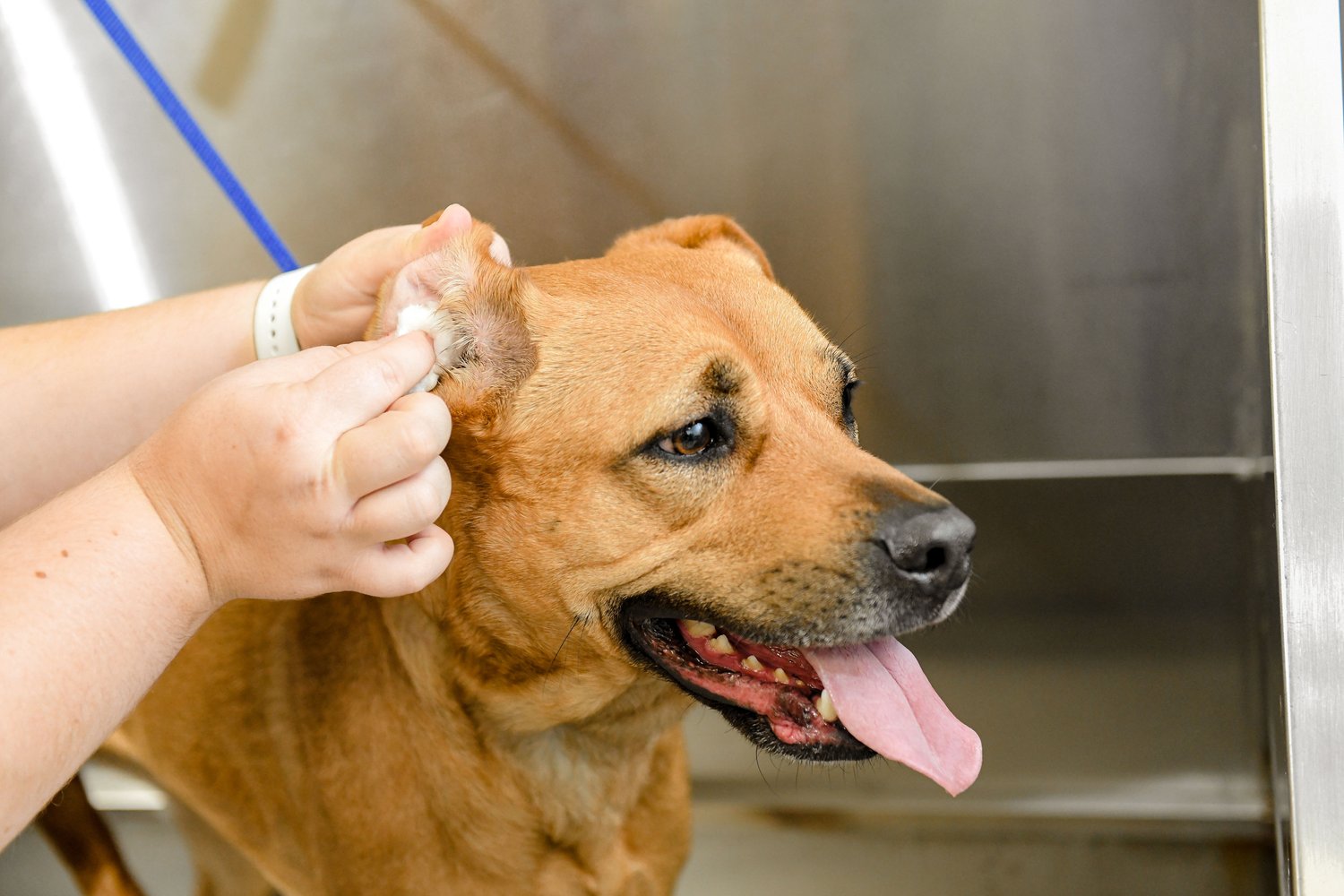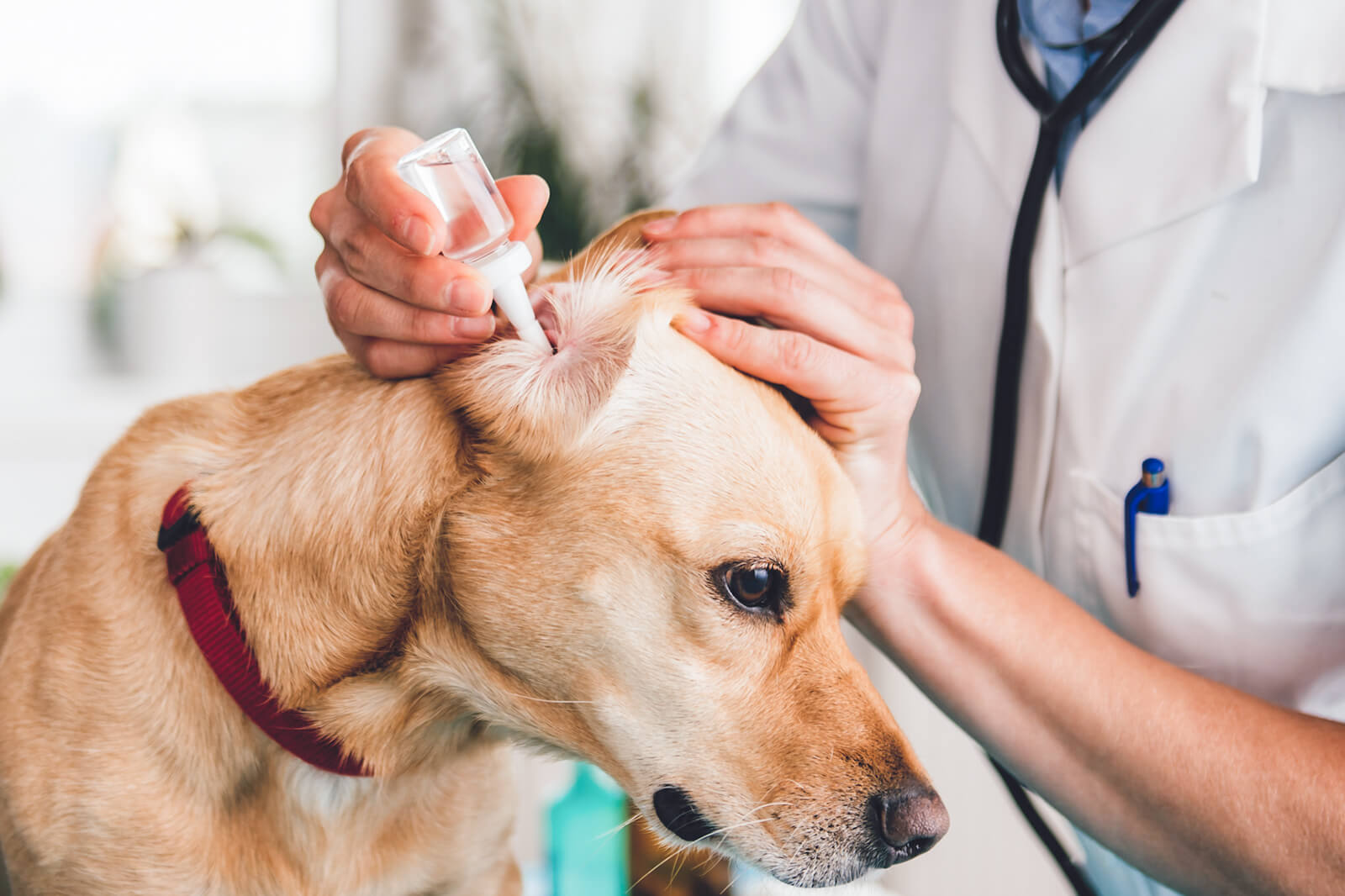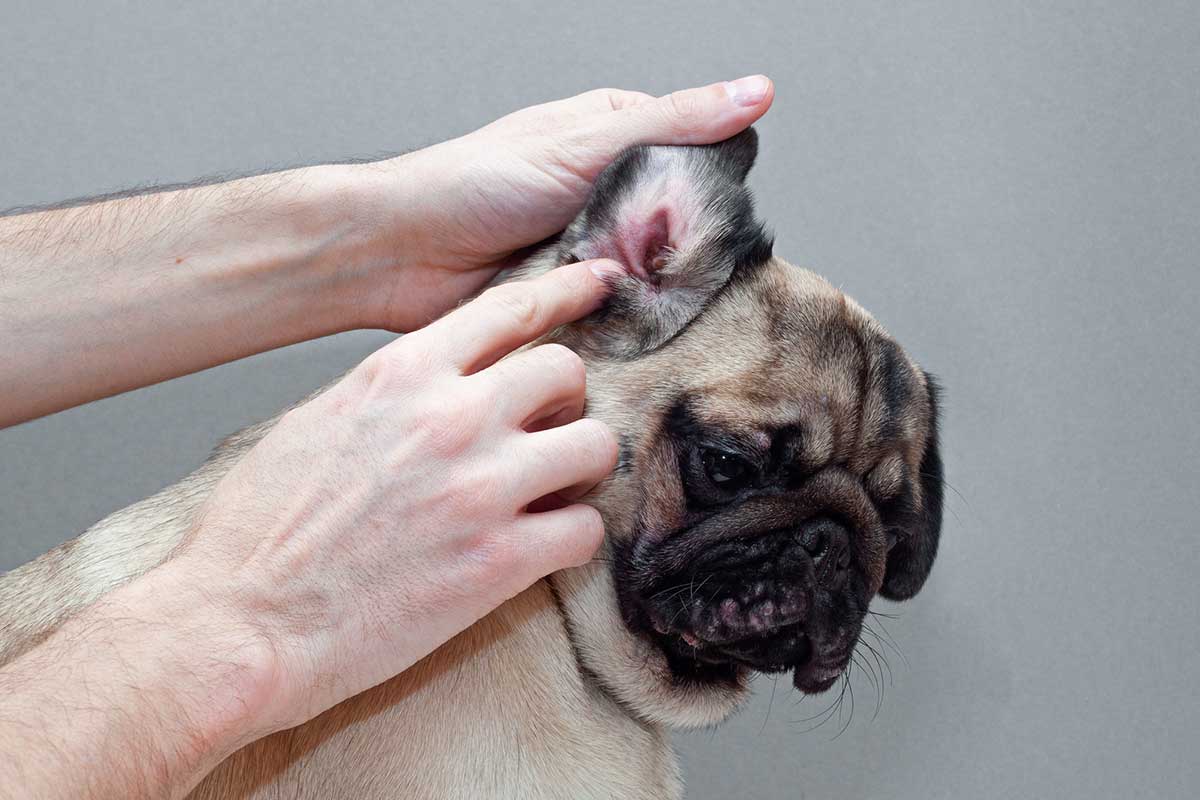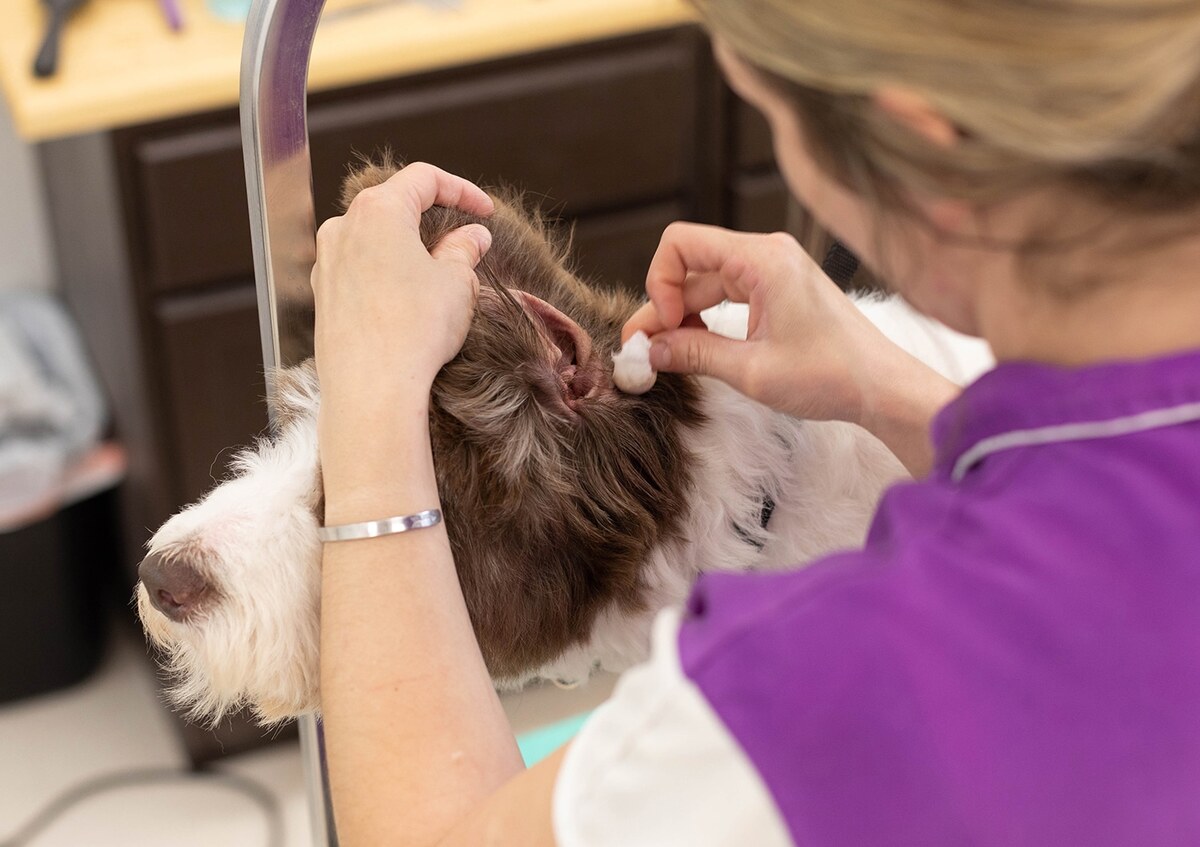Home>Health & Wellness>Common Health Issues>Eye and Ear Health>What Symptoms Do Dogs Experience With Ear Infections
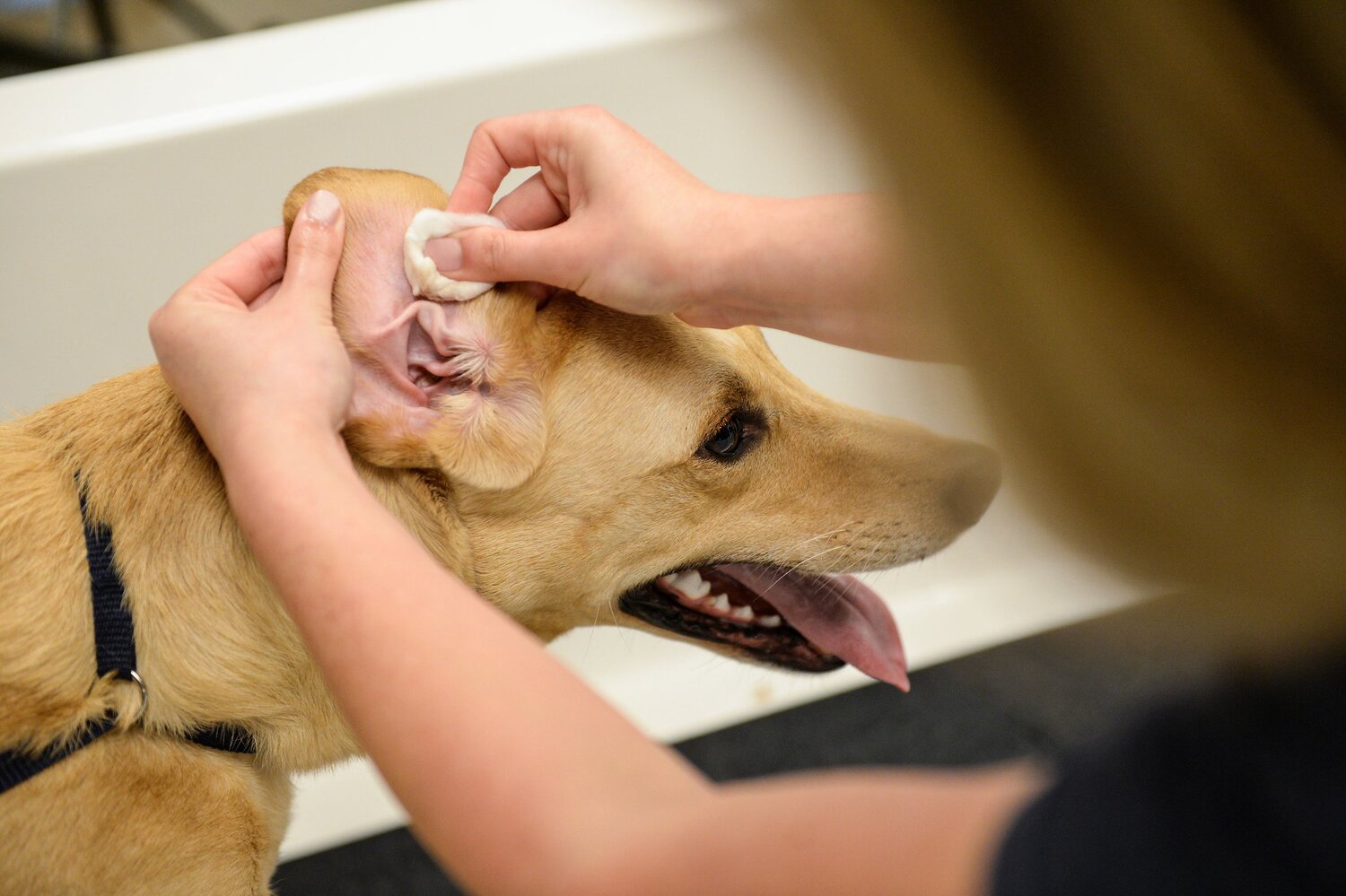

Eye and Ear Health
What Symptoms Do Dogs Experience With Ear Infections
Published: February 15, 2024
Learn about the symptoms of ear infections in dogs and how to maintain their eye and ear health. Find expert tips and advice here.
(Many of the links in this article redirect to a specific reviewed product. Your purchase of these products through affiliate links helps to generate commission for Pawsomeoldies.com, at no extra cost. Learn more)
Table of Contents
Introduction
Ear infections are a common health issue that can affect dogs of all breeds and ages. These infections, also known as otitis externa, occur when the ear canal becomes inflamed and infected. This condition can cause discomfort and distress for our furry friends, making it essential for dog owners to be aware of the signs, symptoms, and treatment options for ear infections in dogs.
Understanding the underlying causes of ear infections in dogs is crucial for prevention and early intervention. By recognizing the symptoms and seeking prompt veterinary care, pet owners can help alleviate their dog's discomfort and prevent the condition from escalating into a more serious health concern.
In this comprehensive guide, we will delve into the common causes of ear infections in dogs, the signs and symptoms to watch out for, the diagnostic process, treatment options, and preventive measures. By gaining insight into these aspects, dog owners can equip themselves with the knowledge needed to safeguard their pet's ear health and overall well-being. Let's embark on this journey to explore the world of ear infections in dogs and discover how we can support our canine companions through these challenging times.
Read more: What To Treat A Dog’s Ear Infection With
Common Causes of Ear Infections in Dogs
Ear infections in dogs can stem from various factors, and understanding the common causes is essential for preventing and addressing this prevalent health issue. Here are the primary factors that contribute to ear infections in dogs:
-
Breed Predisposition: Certain dog breeds, such as Cocker Spaniels, Basset Hounds, and Retrievers, are more susceptible to ear infections due to their floppy ears and hair growth within the ear canals. These characteristics create a warm, moist environment ideal for the proliferation of bacteria and yeast, leading to a higher risk of ear infections.
-
Allergies: Dogs can develop allergies to environmental factors, such as pollen, dust mites, or mold, as well as food allergies. Allergic reactions can trigger inflammation in the ears, making them more prone to infections. Additionally, allergies can lead to excessive scratching and head shaking, further exacerbating the risk of ear infections.
-
Ear Anatomy: Dogs with long, pendulous ears or those with narrow ear canals are predisposed to ear infections. These structural features can impede air circulation and trap moisture, creating a conducive environment for the growth of microorganisms.
-
Moisture and Humidity: Excessive moisture in the ear canal, whether from swimming, bathing, or humid weather conditions, can create an environment where bacteria and yeast thrive. Failure to dry the ears properly after exposure to moisture can contribute to the development of ear infections.
-
Foreign Objects: Dogs may inadvertently introduce foreign objects, such as grass seeds or small debris, into their ear canals while exploring outdoor environments. These foreign bodies can cause irritation and lead to infections if not promptly removed.
-
Poor Ear Hygiene: Inadequate ear cleaning and maintenance can lead to the accumulation of wax, debris, and microorganisms in the ear canal, increasing the risk of infections. Neglecting routine ear care can create an environment conducive to the proliferation of bacteria and yeast.
-
Hormonal Imbalances: Endocrine disorders, such as hypothyroidism or Cushing's disease, can disrupt the natural balance of hormones in a dog's body, potentially impacting the health of the skin and ears. Hormonal imbalances may contribute to increased susceptibility to ear infections.
By recognizing these common causes of ear infections in dogs, pet owners can take proactive measures to mitigate risk factors and prioritize their dog's ear health. Through regular monitoring, proper hygiene practices, and prompt veterinary attention, the impact of these predisposing factors can be minimized, promoting overall well-being for our beloved canine companions.
Signs and Symptoms of Ear Infections in Dogs
Identifying the signs and symptoms of ear infections in dogs is crucial for timely intervention and effective management of this common health issue. While dogs may exhibit varying degrees of discomfort and distress, several key indicators can signal the presence of an ear infection. By recognizing these signs, pet owners can promptly seek veterinary care, alleviating their dog's discomfort and preventing the condition from progressing.
Common Signs and Symptoms:
-
Ear Scratching and Head Shaking: Dogs with ear infections often display persistent scratching at the affected ear(s) and vigorous head shaking. This behavior is indicative of discomfort and irritation within the ear canal, as the dog attempts to alleviate the itching and discomfort caused by the infection.
-
Foul Odor: A distinct, unpleasant odor emanating from the dog's ears can indicate the presence of an infection. This odor is often accompanied by discharge, which may appear dark, brown, or waxy in nature. The foul smell is a result of the accumulation of debris, bacteria, and yeast within the ear canal.
-
Redness and Swelling: Inflamed and swollen ear tissue, often accompanied by redness, is a visible indicator of an ear infection. The ear may appear tender to the touch, and the dog may exhibit signs of discomfort when the affected ear is manipulated or palpated.
-
Excessive Ear Rubbing: Dogs may rub their affected ear against furniture, carpets, or other surfaces in an attempt to relieve the discomfort caused by the infection. This behavior is a clear indication of irritation and discomfort within the ear canal.
-
Tilting of the Head: A noticeable tilt or tilt of the head to one side can signal an ear infection. This posture may be accompanied by a loss of balance or coordination, indicating that the infection has affected the dog's equilibrium.
-
Behavioral Changes: Dogs with ear infections may exhibit changes in behavior, such as irritability, restlessness, or reluctance to be touched around the head and ears. These behavioral changes stem from the discomfort and pain associated with the infection.
-
Hearing Loss: In severe cases, ear infections can lead to temporary or permanent hearing loss in affected ears. Pet owners should be vigilant for signs of reduced responsiveness to auditory cues, indicating potential hearing impairment.
By remaining vigilant and attentive to these signs and symptoms, dog owners can promptly address ear infections, ensuring the well-being and comfort of their beloved pets. Seeking professional veterinary care is essential for accurate diagnosis and tailored treatment, ultimately promoting the swift recovery of dogs affected by ear infections.
Diagnosing Ear Infections in Dogs
Accurate diagnosis is pivotal in effectively addressing ear infections in dogs, as it enables veterinarians to tailor treatment plans to the specific needs of each canine patient. When a dog exhibits symptoms indicative of an ear infection, a thorough diagnostic process is essential to identify the underlying cause and determine the most appropriate course of action. Here's an overview of the diagnostic methods commonly employed to assess and diagnose ear infections in dogs:
Physical Examination:
The diagnostic journey typically commences with a comprehensive physical examination conducted by a veterinarian. During this assessment, the veterinarian carefully inspects the dog's ears for signs of inflammation, discharge, odor, and visible abnormalities. Palpation of the ear canals may also be performed to assess tenderness, swelling, or the presence of foreign objects. Additionally, the veterinarian may observe the dog's behavior and response to ear manipulation, providing valuable insights into the extent of discomfort and potential complications.
Otoscopic Examination:
An otoscopic examination involves the use of a specialized instrument called an otoscope to visualize the internal structures of the ear canal. This enables the veterinarian to assess the presence of inflammation, excessive wax buildup, foreign objects, and the condition of the eardrum. By gaining a clear view of the ear canal, the veterinarian can identify signs of infection, such as redness, swelling, and the presence of discharge or abnormal tissue growth.
Microscopic Evaluation:
In cases where discharge or debris is present in the ear canal, a sample may be collected for microscopic evaluation. This involves examining the collected material under a microscope to identify the types of microorganisms present, such as bacteria, yeast, or parasites. Microscopic analysis provides valuable information regarding the specific pathogens contributing to the ear infection, guiding the selection of targeted treatment options.
Culture and Sensitivity Testing:
In instances where the ear infection is recurrent, severe, or unresponsive to initial treatments, a culture and sensitivity test may be recommended. This diagnostic test involves obtaining a sample from the affected ear and culturing it in a laboratory to identify the specific microorganisms present. Additionally, sensitivity testing is performed to determine the most effective antimicrobial agents for combating the identified pathogens. This tailored approach ensures that the chosen treatment is optimally suited to combat the causative microorganisms, enhancing treatment efficacy.
By employing these diagnostic methods in a comprehensive and systematic manner, veterinarians can accurately assess and diagnose ear infections in dogs, laying the foundation for targeted and effective treatment strategies. This proactive approach not only addresses the immediate symptoms but also contributes to the long-term ear health and well-being of canine companions.
Treatment Options for Ear Infections in Dogs
Upon the confirmation of an ear infection in a dog, prompt and appropriate treatment is essential to alleviate discomfort, resolve the infection, and prevent potential complications. The selection of treatment options is guided by the underlying cause of the infection, the severity of symptoms, and the specific pathogens involved. Here are the primary treatment modalities commonly employed to address ear infections in dogs:
-
Ear Cleansing: Thorough cleansing of the affected ear(s) is a fundamental step in managing ear infections. Veterinarians may recommend specialized ear cleansing solutions to gently remove debris, wax, and accumulated discharge from the ear canal. This process not only enhances the effectiveness of subsequent treatments but also promotes a healthier ear environment by eliminating factors conducive to infection.
-
Topical Medications: The application of topical medications directly into the ear canal is a common approach to combat ear infections. Veterinarians may prescribe antimicrobial ear drops or ointments containing antibiotics, antifungals, or corticosteroids, depending on the nature of the infection. These medications target the causative microorganisms and reduce inflammation, facilitating the resolution of the infection.
-
Systemic Therapy: In cases of severe or recurrent ear infections, systemic therapy involving oral medications may be necessary. Oral antibiotics, antifungals, or anti-inflammatory drugs can be prescribed to address systemic infections, alleviate inflammation, and target pathogens that may be challenging to reach with topical treatments.
-
Underlying Condition Management: Addressing underlying factors contributing to ear infections is crucial for long-term management. For instance, managing allergies through dietary modifications, environmental controls, or allergy medications can reduce the frequency and severity of ear infections. Additionally, addressing hormonal imbalances or anatomical predispositions can play a pivotal role in preventing recurrent infections.
-
Follow-Up Care: After initiating treatment, regular follow-up appointments with the veterinarian are essential to monitor the dog's progress and make any necessary adjustments to the treatment plan. Follow-up examinations may involve re-evaluating the ear canal, assessing treatment response, and modifying the therapeutic approach as needed to ensure optimal outcomes.
-
Preventive Measures: Educating pet owners about preventive measures, such as routine ear cleaning, proper grooming practices, and environmental modifications, is integral to minimizing the risk of recurrent ear infections. By implementing preventive strategies, pet owners can actively contribute to their dog's ear health and overall well-being.
By tailoring treatment to the specific needs of each dog and addressing the underlying factors contributing to ear infections, veterinarians can effectively manage this common health issue. Through a combination of targeted therapies, diligent care, and preventive measures, dogs can experience relief from ear infections and enjoy improved ear health, enhancing their quality of life and strengthening the bond with their devoted owners.
Preventing Ear Infections in Dogs
Preventing ear infections in dogs is a proactive endeavor that encompasses various strategies aimed at minimizing risk factors and promoting optimal ear health. By implementing preventive measures, pet owners can play a pivotal role in safeguarding their canine companions from the discomfort and complications associated with ear infections. Here are essential guidelines for preventing ear infections in dogs:
-
Regular Ear Inspection and Cleaning: Establishing a routine for inspecting and cleaning your dog's ears is fundamental in preventing infections. Regularly examine the ears for signs of redness, swelling, or abnormal discharge, and gently clean the ears using veterinarian-recommended ear cleansing solutions. Proper ear hygiene helps remove excess wax and debris, reducing the likelihood of microbial overgrowth.
-
Grooming and Hair Management: For dogs with long, pendulous ears or breeds predisposed to ear infections, maintaining proper grooming practices is crucial. Keeping the hair around the ears trimmed and well-maintained promotes air circulation and minimizes moisture retention, creating an inhospitable environment for bacteria and yeast.
-
Ear Protection During Water Activities: When engaging in water-related activities, such as swimming or bathing, take precautions to protect your dog's ears from excessive moisture. Use specialized ear drying solutions or gently dry the ears with a soft cloth after water exposure to prevent the accumulation of moisture, a common precursor to ear infections.
-
Allergy Management: If your dog has known allergies, work closely with your veterinarian to manage and mitigate allergic reactions. Implementing allergy management strategies, such as dietary modifications, allergy medications, and environmental controls, can reduce the risk of allergic otitis, a common trigger for ear infections.
-
Regular Veterinary Check-ups: Schedule routine veterinary examinations to monitor your dog's overall health, including the condition of the ears. Veterinarians can provide valuable guidance on preventive care, assess the ears for early signs of inflammation or infection, and recommend tailored preventive measures based on your dog's specific needs.
-
Healthy Diet and Nutrition: Providing a balanced and nutritious diet supports your dog's immune system and overall well-being, contributing to the maintenance of healthy skin and ears. Consult with your veterinarian to ensure that your dog's diet meets their nutritional requirements, promoting optimal ear health from within.
-
Environmental Modifications: Create an environment conducive to ear health by minimizing exposure to potential irritants and allergens. Regularly clean your dog's living spaces, including bedding and play areas, to reduce the accumulation of dust, pollen, and other environmental triggers that can contribute to ear inflammation.
By integrating these preventive measures into your dog's care routine, you can significantly reduce the risk of ear infections and promote long-term ear health. Proactive and attentive care, coupled with regular veterinary guidance, empowers pet owners to prioritize their dog's well-being and ensure a comfortable, infection-free life for their beloved canine companions.
Conclusion
In conclusion, ear infections in dogs are a prevalent and distressing health concern that can significantly impact the well-being of our beloved canine companions. By gaining a comprehensive understanding of the common causes, signs, and treatment options for ear infections, pet owners can proactively safeguard their dog's ear health and mitigate the risk of this discomforting condition.
Recognizing the predisposing factors, such as breed-related anatomical traits, allergies, and poor ear hygiene, empowers pet owners to implement targeted preventive measures. Regular ear inspections, grooming practices, and environmental modifications play a pivotal role in minimizing the risk of ear infections, fostering a healthier and more comfortable life for dogs.
Moreover, vigilance regarding the signs and symptoms of ear infections is paramount, as early detection enables prompt veterinary intervention and tailored treatment. By addressing discomfort, inflammation, and the underlying causes of the infection, veterinarians can guide dogs towards a swift recovery and improved ear health.
The diagnostic process, encompassing physical examinations, otoscopic evaluations, and microscopic analyses, facilitates accurate identification of ear infections and guides the selection of appropriate treatment modalities. Tailored therapies, including ear cleansing, topical and systemic medications, and holistic management of underlying conditions, form the cornerstone of effective treatment strategies.
Furthermore, preventive measures, such as regular ear care, allergy management, and environmental modifications, are instrumental in minimizing the recurrence of ear infections, promoting long-term ear health, and enhancing the overall quality of life for dogs.
By prioritizing preventive care, prompt intervention, and attentive management, pet owners can champion their dog's ear health, fostering a harmonious and fulfilling companionship. Through collaboration with veterinary professionals and the implementation of proactive measures, we can create a world where dogs thrive in comfort and vitality, free from the burden of ear infections.
